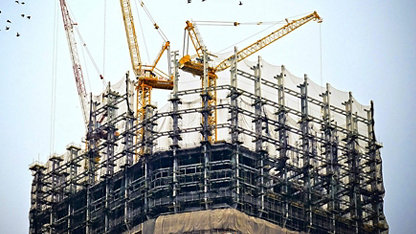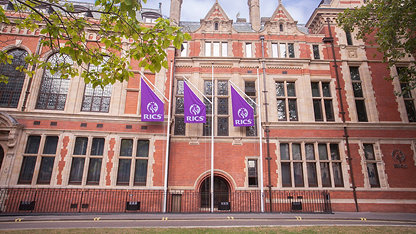RICS Asia-Pacific construction sector insights Q4 2022
High inflation and fear of a looming recession are producing headwinds for the construction sector in APAC. The APAC construction sector continues to present a mixed picture in the fourth quarter of 2022. With this as a backdrop, leaders across the APAC region participated in RICS Leaders' forums held during the last quarter of 2022. The forums were held in the five core hubs of APAC, covering (1) Australia and New Zealand, (2) China, (3) Hong Kong, (4) India, and (5) Southeast Asia.
To facilitate the discussion during these sessions, the following three prompts were used:
- Strategies to address material and labour availability in a shortage economy (in a market with weak demand from the private sector and strong intervention from the government, what are the strategies for the construction industry to adapt to the changes?)
- COVID Tail and its impact on construction productivity, costs, and tender prices (facing increasing market risk, what are the firms' strategies for talent retention, upskilling, and organisation transformation?)
- Data and digital tools for measuring and reducing embodied carbon.
The following subsections summarise the discussions held during the Leaders' Forum under the Chatham House Rule.
1.1 Strategies to address material and labour availability in a shortage economy
Participating RICS members highlighted the importance of understanding the contours of the shortage economy and its implications on project delivery. Primarily projects are facing challenges in the procurement of materials and in recruiting and retaining personnel. The Australian and New Zealand markets are both constrained regarding materials and labour, and strong signs are that this is a regional and global phenomenon. There is also a looming risk of a recession, which the sector cannot control and must watch for to adjust with the market and hedge where possible. There remains much uncertainty in the short, medium, and long term, and the supply chain is using pricing strategies to price these uncertainties.
Discussions relating to personnel first focused on the shortage of construction labour. Labour is by far the most significant issue, as most projects cannot find the right people. Investments in infrastructure projects are exerting significant pressure on the labour market. In some APAC areas, there is significant availability of low-skilled construction labour but utilisation of this type of labour results in poor productivity and lower quality. Some regions reported that the construction labour shortage is severe because many high-skill construction workers are lost to projects in the middle east, where salaries are more attractive compared to the domestic market. This imbalance leads to the importation of foreign labour from other low-income countries. Particularly Southeast Asia is seeing high importation of construction labour. There is a significant variation in the construction labour market. For example, in Thailand, there is a high proportion of untapped low-skilled labour, whereas, in Singapore, 100% of labour is imported. The unions' position of a fixed percentage increase in wages across the board has now changed to wage increases to match inflation which will only add to labour costs. Labour force is now telling contractors when they will be available for a project. There are more significant shortages in the regions. Pent-up demand for travel is also disrupting the industry.
Similar challenges are also seen on the skilled professional's front. Trained quantity surveyors and project managers are simply not available in the market. Due to significant investments in infrastructure, demand is higher than supply, and therefore skilled professionals are in a demanding position. They can afford to be picky and choose the employer they feel best aligns with their interests. A significant number of professionals available in the job market lack vital skills. Leaders discussed the issue of skills and competencies in detail. Role of professional bodies such as RICS was discussed. It is clear from the discussions that the industry needs to work with universities, public and private sector client groups, and professional bodies to change the situation through awareness, training, and upskilling programs. The industry needs to upskill people so they can do more rather than execute low-skilled jobs with low salaries.
Materials shortages are easing and plateauing to higher than pre-COVID prices, although there are continuing issues for timber, bricks, tiles, lifts, and a range of other products and components. There is increased uncertainty now about some materials. Previously suppliers could provide a date and cost, but now they cannot do this for some essential items, which can be on the critical path for projects. Instead of getting timeframes and prices, project teams are now told, "you will get it when you get it." Global construction prices like steel and shipping costs have reduced and come back, although not at pre-COVID levels.
Having discussed the challenges, the leaders next discussed the following possible opportunities and solutions:
- Prefabrication is an obvious solution because it helps reduce the time spent on site. Adopting technology is the other obvious path forward and will significantly reduce the labour-dependency. With the use of appropriate technology, reliance on low-skilled labour can be reduced, and on-site assembly can be streamlined, leading to higher productivity, improved quality, and reduced waste.
- Employers, contractors, and designers need to work closer together in the design phase so that issues in material and labour can be addressed early. Real-time data can provide better market visibility to address material and labour shortage issues.
- Building information modelling (BIM) was also discussed as a possible tool to assist in breaking down silos and harnessing the full power of data. An end-to-end solution on construction sites is needed to address these challenges.
- The risk management approach needs to improve. Greater collaboration between clients, contractors, and the rest of the supply chain is necessary and important to improve the operating environment in which projects are delivered. There is so much work available that if the client isn't open-minded and prepared to share some of the levels of risk, then contractors are very often choosing to walk away from a project. A robust and disciplined approach to risk management is being employed, including pricing risk where it is known and, if it is unknown, treating it as an adjustment event through a collaborative approach with the client. Significant collaboration through alliances with client, contractors, and suppliers to work through these extraordinary times are also an option.
- Other strategies include buying in advance and warehousing, which adds to the cost. Some attempts are being made to change contracts to reflect the rise and fall of prices retrospectively, but this is not easy to do and protect profitability. There is a view that in the long term, over 8-10 years, prices and risk will settle, and some infrastructure sector projects should be pushed into that timeframe.
- The leaders emphasized the necessity of training high-quality professionals to meet the needs of the whole project process. Skills and talents related to project planning, digital management, sustainable development, collaboration, and coordination are highly sought after. The sector needs to make efforts to improve skills related to project management, contract practice, laws and regulations, technology, measurement, and pricing. The leaders earnestly hoped that RICS could assist in providing effective systematic training and exchange activities.
1.2 COVID Tail and its impact on construction productivity, costs, and tender prices
The construction sector has not fully recovered from COVID, and there are lingering issues related to productivity, cost, and tender prices. Construction productivity is not back to the pre-pandemic levels, and costs and tender prices are also above these levels.
Labour shortages continue to pressure the sector and lead to lower productivity. Detrimental weather, such as rain events in some parts of APAC, has also reduced productivity. For example, in Singapore, many workers returned to their country of origin. Therefore, labour costs have risen significantly, and tenders have increased by 30 to 40% on average.
Demand by labour for better working conditions and work culture, rejection of toxic work culture, permanent transition to higher levels of work from home (WFH), much greater demand for flexible working arrangements, and much greater integration of the use of technology into day to operations are seen as an important aspect during the COVID tail.
High wages through increases in awards due to union activity automatically passed through contracts to clients are leading to higher tender prices. Tender prices reflect higher levels of risk, higher wages, and material costs. Quantity surveyors are factoring in continued price rises monthly.
Companies are adopting more modern methods of construction to address productivity challenges. Digital tools are also playing an increased role in addressing increasing costs. Data is being deployed to better address price volatilities and supply chain snarls. However, there are still some challenges regarding technology providing meaningful data to manage and report on productivity and cost.
Commodity prices were already increasing before Covid. The industry has transferred more risks onto the contractors and asked them to absorb them and accept fixed-price contracts. Then expect these to work on a 3-5% margin, which means profit margins are very low. Globally listed construction companies declare EBITDA of less than 3%, and this poses a significant risk of bankruptcies and project failures.
Today commodity prices are off their peaks, and steel is only 5% up from pre-pandemic prices. Container and transport costs are back to pre-covid levels too.
1.3 Data and digital tools for measuring and reducing embodied carbon
The leaders in APAC agreed that the construction sector has an essential role in addressing carbon emissions from buildings and infrastructure assets. However, much more needs to be done to address the climate crisis by the sector. Governments need to lead the way in driving sustainability and reducing carbon emissions. It is essential to ensure equal emphasis is placed on embodied and operational carbon by adopting a whole-of-life approach for projects and assets.
There is a variation in awareness and action across various regional public and private sector clients. Top-tier clients are very well-progressed in terms of both embodied carbon and operational carbon. Customers in the residential sector have not fully embraced the concept of carbon footprint, especially the growing importance of embodied carbon. Therefore, governments should create more incentives to encourage carbon reduction in the built environment. There is a lack of awareness about net zero carbon in Tier 2 and Tier 3 contractors/ developers. Construction companies have a role in educating second-tier developers who are not as progressed on this issue.
While awareness remains a challenge, an equally important challenge that needs to be overcome is the perception that reducing carbon emissions from constructed assets would mean higher overall costs. These misconceptions can be addressed using life cycle costing, and project teams can make prudent decisions.
There is a global absence of knowledge and regulation on how carbon needs to be measured and calculated, as this area is emerging. Lack of availability of accurate data, benchmarks, and standards was highlighted as some of the barriers. From the discussions, it was clear that on this front RICS has an incredibly important leadership role in promoting ICMS, Whole Life Carbon Assessment Professional Standard, and other global standards to help reduce life cycle carbon emissions. The leaders attending the meeting suggested that RICS could assist in providing more systematic training of professional skills and exchange activities to share global best practices with members. ICMS 3rd edition is an effective tool to record carbon during the construction life cycle. But there is also a need for universal benchmarks and databases like the Built Environment Carbon Database to promote standardisation in calculating and reporting embodied and operational carbon. Consistent reporting is important to avoid greenwashing.
Carbon emission planning and reporting is a promising service area. As carbon emission measurement is closely related to cost engineering, quantity surveyors, and cost management professionals must play a crucial role. RICS should work with members and member firms to raise awareness, especially among small and medium enterprises.
Leaders agreed that there is a need to utilise BIM more efficiently to integrate cost and carbon calculations. Cost, carbon, and BIM should be implemented effectively and is the way forward. Standardisation is necessary. Digital tools will develop at pace, but the speed at which the industry can adopt sustainable targets remains an issue. Organisations are setting targets and making decarbonisation commitments etc., but many organisations do not know how to achieve these targets. Digital tools such as BIM and digital twins are needed, but standardisation and an internationally agreed methodology are still significant barriers.
As the construction industry struggles to survive, most developers don't state in their contracts that carbon measurement is necessary. This poses the question of what motivation contractors have for doing this.
Training on the proper use of these tools is also crucial. It's not just about building with less polluting materials but also building better for more prolonged use. And take it a step further and repurpose and recycle existing structures. Linking carbon reporting to existing sustainability programs such as Green Mark, BREAM, and NABERS is essential.
1.4 Closing comments
The leaders at the meeting all believed that despite the considerable uncertainties in 2023, the construction industry would still have a good prospect, and there would still be opportunities in the infrastructure field. So, the sector would still be "cautiously optimistic" about the development of the construction industry, but pockets of opportunity exist that industry players must tap into. Geopolitical issues are still contributing to the volatility, and the industry must get used to this volatility in the future, as the situation is unlikely to improve in 2023. The cost of doing business has increased because of the silent resignation. Thus, the attrition rate and the cost of employing new people are high. The leaders see data, digital tools, and prefabrication as solutions to these problems. Significant investments in training and upskilling are also needed.












